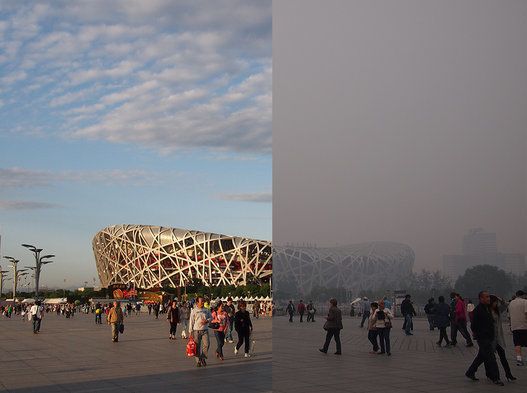
On Wednesday, residents in the national capital didn't need to see any data to know how bad the air pollution situation had become. Their eyes watered and itched from the apocalyptic-looking, dark blanket of smoke, and even people with no history of respiratory issues complained of difficulty in breathing. President Pranab Mukherjee's doctor Lt Gen BNBM Prasad termed the alarming levels of pollution a "death sentence" for children and the elderly.
On Thursday morning, poor visibility from the smog led to a tragic pile-up involving 20 cars on a busy highway stretch just outside Delhi, causing at least one death and several injuries.
The smoke ominously seeped through our pollution-free safe places — offices, vehicles, living rooms — and our social media timelines began flooding with hazy pictures of the smog. Some residents began frantically sharing tips on how to protect themselves with pollution masks, air purifiers and plants.
Yet, even after three straight days of dangerous levels of pollution — the peak levels of pollution (PM2.5 and PM10), reached over ten times the safe limit on Wednesday — the government of Delhi and at the Centre are yet to implement any concrete steps to protect its citizens.
Faced with similar circumstances, neighbouring China, which also has a well-known smog problem in winter months, issues regular health advisory to residents based on different levels of colour-coded alerts. A red alert, for instance, prompts the government to declare schools shut, halt construction activity, and take vehicles off the roads.
In contrast, Delhi's air quality index has been more than twice as bad as China's last red alert when its air quality reached 300, which was 40 times over the World Health Organisation's healthy limit, but no such public health advisories had been issued by the Indian government as of Thursday afternoon.
Before Diwali, the government of Delhi had made promises of installing air purifiers and mist fountains at major city intersections, but these aren't operational yet. On Wednesday, the Delhi government somewhat belatedly released a 'Kejriwal app' in an effort to appease residents, asking them to share pollution-related grievances, and announced measures such as vacuuming construction dust. On Thursday afternoon, the Environmental Ministry said it planned to issue an advisory shortly to states on how to tackle the problem but has stopped short of saying exactly what those steps will entail.
To be sure, there is not one single cause behind the air pollution mess in Delhi. A combination of factors including the unregulated use of Diwali firecrackers, vehicular pollution, and indiscriminate crop burning in neighbouring states of Punjab and Haryana are to blame. Last winter, Delhi briefly introduced the odd-even vehicle scheme that Delhi residents reluctantly embraced but pollution data later cast doubts on how successful that scheme was in improving the capital's air quality.
Sadly, the conversation and headlines on pollution fizzled out as quickly as the spring and summer heat set in, sweeping the pollutants away from our sight, and from our minds — until now.
Given the dangerous levels of pollution, it's clear that nothing short of an urgent effort by both states and the central government is needed to check this mess. It should no longer alarm anyone what months of October and November are almost certain to bring every year in the absence of active pollution-controlling measures.
The right to clean air and water is a fundamental right of each citizen, and it is imperative that the government take tough steps to protect citizens from an unfolding environmental disaster.
It's 2016 — should we be still wishing for winds to just blow away the dark matter that's choking us?
Also on HuffPost:
